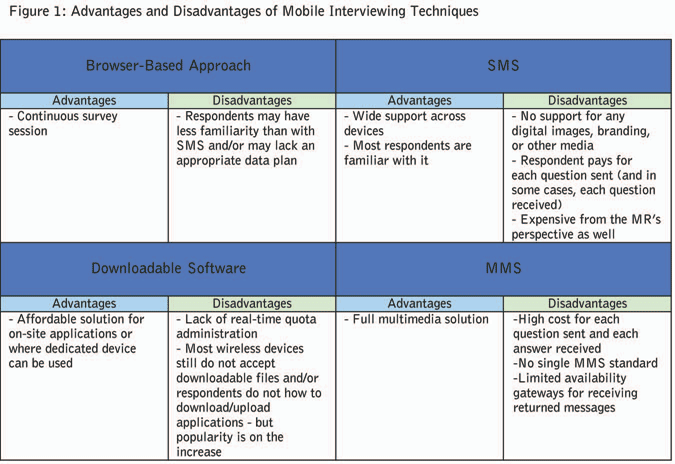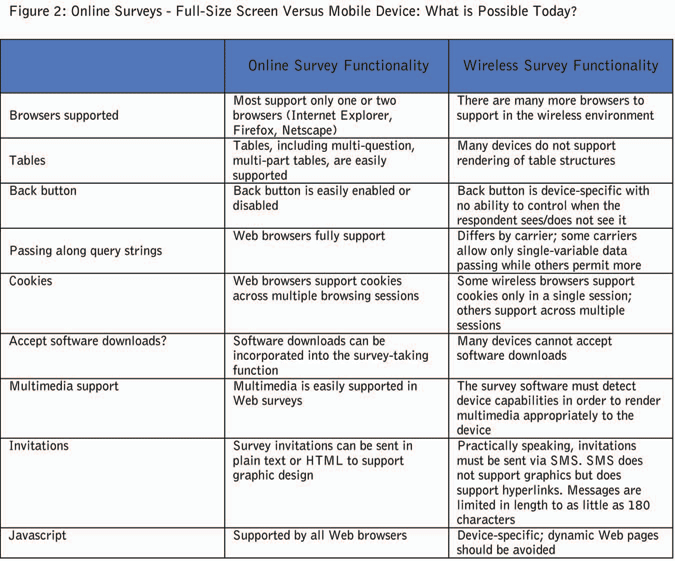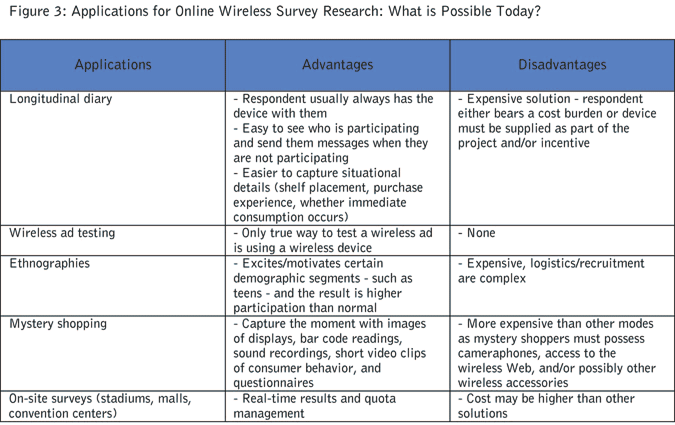Editor’s note: Leslie Townsend is president of Dallas-based Kinesis Survey Technologies LLC.
Thumbpower refers to the use of a tool that is in the pocket or purse of most adults and many teenagers: the cell phone. An entire generation is being raised to send text messages, surf the Web and conduct transactions on their cell phones using their increasingly adept thumbs.
The market research industry has yet to widely embrace wireless data collection using cell phones and PDAs. Adoption of mobile data collection, known as computer-aided mobile interviewing (CAMI), is higher in Europe and Asia than in the Americas. There are numerous barriers to wider adoption of survey deployment on wireless devices. Mobile panels are virtually non-existent and not broadly representative, incentive structures unexplored, and many still struggle with where CAMI might be useful. Wireless survey solutions are analogous to online survey solutions, circa 1995, in terms of deployment.
Even more fundamental than issues of panel source and appropriate incentives is how wireless surveys are best administered. Current wireless solutions on the market support survey administration in one of four modes:
1. In a single, real-time, continuous session via WAP and other wireless Web protocols, supporting the viewing of digital images and other media.
2. In a discontinuous session administered via SMS (Short Message Service). As SMS does not support multimedia, digital images and other media cannot be utilized within the survey.
3. Via a non-real-time solution utilizing downloadable software, and for reasons of practicality generally requiring the use of a device dedicated to survey use.
4. Via MMS (Multimedia Messaging Service). This mode supports the sending and receiving of digital images and other media within a survey question and/or response. MMS works like SMS, so questions and responses are sent and received in discontinuous sessions.
Our firm advocates the use of the wireless Web for most U.S. surveys for several reasons:
- As with other forms of online research, the wireless Web establishes a continuous survey session.
- The wireless Web is generally perceived as a more cost-effective solution than SMS by respondents, since they do not incur per-message charges.
- It is more cost-effective for the market research company to deploy with the wireless Web.
- Digital images and other media can be used within the survey, such as for template-branding or concept display.
- The survey can render the best possible functionality to the device, based upon a library of device capabilities such as browser in use.
Survey functionality
By utilizing the wireless Web as opposed to one of the other survey modes described in Figure 1, the majority of functions of a Web survey are supported. For instance, it is possible to randomize and anchor concepts; include conditional branching; create validation (ensuring that responses fall within a range that is considered reasonable); administer quotas; display images and streaming media; and brand the survey when programming.

On the other hand, many functions associated with Web surveys are not supported, at least currently, on wireless devices. Some survey functionality is device-specific. Most cell phone browsers do not accommodate even simple table structures and many do not enable a back button at all times.

Wireless Web surveys continue to lag behind traditional Web surveys in functionality due to inherent limitations of a small screen size. However, rapid developments in mobile devices, such as foldable screens, ensure that the wireless Web survey rendering will continue to improve for respondents. Figure 2 compares the capabilities of browser-based Web surveys versus browser-based wireless surveys.
Panel and incentive challenges
Within the U.S. market research industry, panels are typically used as the means of obtaining an opt-in group of individuals for survey-taking. Respondents are compensated in various ways - through contests, point schemes that accrue toward cash or prizes, or by electronic gift certificates. Traditional opt-in panels are rare in the wireless survey research world, although there are several established SMS communities that might represent a type of “list” substitute. However, SMS communities are by their very nature biased and focused upon specific types of content (such as dating, or hip-hop music) and most have not opted into the survey-taking process. The entire area of how best to develop, maintain and provide incentives to wireless survey respondents is still under exploration within the U.S., although wireless panels are beginning to emerge in Europe .
In spite of the many challenges to implementation of wireless surveys, areas of promise are emerging. These applications are highlighted in Figure 3, along with some advantages/disadvantages.

The best approach with wireless surveys is to begin with the least complexity possible. Keep surveys short - less than 20 questions is best. Keep validation to a minimum. Avoid progress bars and other unnecessary images as these may slow the survey down. Where more complex images and videos are to be included, make certain that the survey detects the capabilities of the device and renders in the best possible way (a best practice even where images are not included). Think carefully about how the user will access the URL - URLs are cumbersome to type on mobile phones if you have never done it before. Avoid open-ends wherever possible, as not all thumbs are equally adept.
Find solutions
So where do we take it from here? The wireless industry itself is leading in terms of utilizing its own technologies to solve research problems. Moving wireless survey research to other segments requires a demonstrable need to find solutions for genuine research problems.
One example is the need to find motivating ways to study teen behavior and buying habits through the survey-taking process. Teens may be tired of Web surveys, but they are enthusiastic respondents to any task that is asked of them on a wireless device.
Similarly, buying behaviors, moods, and other situational data often are overlooked in many types of research because the respondent is not taking the survey at the point of purchase or purchase intent. The capture of location information will enrich the meaning of both qualitative and quantitative data, showing, for instance, how far consumers travel to purchase various types of items, or how many locations they visit to make those purchases.
Wireless scanning devices or cameraphones may be used to log purchases on the spot. Personal area networks such as Bluetooth might be used to trigger invitations to take surveys at fast-food chains or similar locations, tied in with new product testing, on-the-spot incentives or coupon delivery to the cell phone. Megapixel cameraphones are appearing on the market with near-DVD quality video capture, MP3 players, videoconferencing capability, and Flash technology - just visit the nearest wireless retailer if you have any doubts about the richness of the media experience on wireless devices. (Some devices are now equipped with two cameras - one for recording high-resolution images and the other for videoconferencing applications.)
With these exciting developments in technology, wireless surveys will continue to be implemented in a more complex and applications-specific fashion while addressing the issues that cannot be readily tackled with typical Web-based solutions. Without a doubt, the future of research activity will include the harnessing of “the power of the thumb.”
